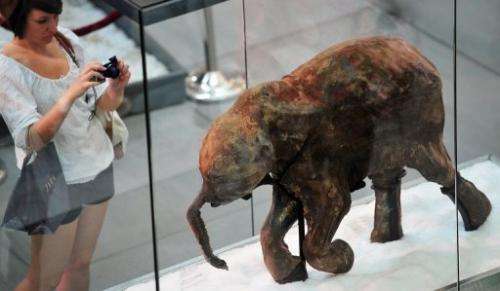A visitor takes pictures of the carcass of the world's most well-preserved baby mammoth in Hong Kong in May 2012. Serbian archaeologists have discovered the remains of at least seven mammoths at a dig at an open pit mine, which could turn out to be a mammoth cemetery, lead archaeologist Miomir Korac told AFP Friday.
Serbian archaeologists have discovered the remains of at least seven mammoths at a dig at an open pit mine, which could turn out to be a mammoth cemetery, lead archaeologist Miomir Korac told AFP Friday.
"We are at the start of the excavations. We first found the remains of one mammoth and then every 30 metres or so the bones of six more animals at the same depth," said Korac, who leads the team carrying out the dig.
The bones, including an almost 2-metre (6.5-foott) tusk, were found in the Kostolac mine some 70 kilometres (45 miles) to the east of Belgrade.
Three years ago the bones of a female mammoth, nicknamed Vika, who lived over a million years ago, were found at the same site.
"The new bones are a lot younger -- up to 100,000 years old -- and are from another species of mammoth, which means the animals used the site for a long period. For us that is an indicator that it could be a cemetery," Korac said, stressing the find was unique.
If it is confirmed to be a mammoth graveyard it would be the first ever discovered.
A mammoth cemetery is similar to the legend of the elephants' graveyard, where older animals are said to instinctively go to die. It has been dismissed as myth by scientists who attribute sites with many elephant bones to group die-offs brought on by malnutrition or natural disaster.
The question for Serbia now is what to do with the site, which is part of a working coal mine that is losing around one million dollars (790,000 euros) during the excavations.
"Our idea is to speed up the excavations and work day and night, but the state will have to decide soon on the future of the site," Korac said.
(c) 2012 AFP




















